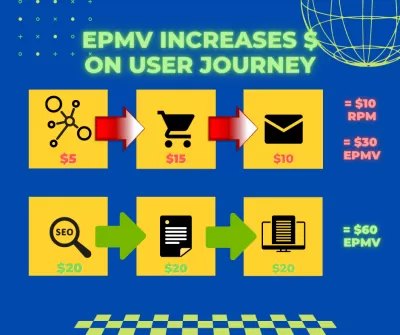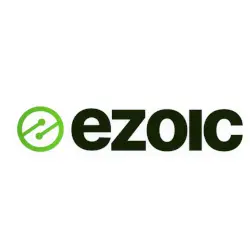What Is EPMV And Why Do You Need It?
A metric that describes success!
EPMV may be a metric you haven't heard of before. This makes sense, since there are so many metrics to track in the world of digital publishing that some of them are bound to slip under the radar.
Recently, however, publishers have begun to use this metric to more accurately measure and optimize website revenues. Let's take a closer look at what it is, why you should use it, and more.
What is EPMV?
EPMV is also known as revenue per thousand visitors or session RPM. Simply put, this metric measures how much money you make for every 1,000 visitors to your entire website, not just a specific page or ad unit.
You can calculate it by:
Calculate EPMV with an example:
In April, the website earned $1,500 from Ezoic, $1,000 from AdSense, and $500 from AdSterra. They monetize their content only through ad monetization. They earned a total of $3,000 in ad revenue in April. However, the traffic they generated was 1,500,000 visitors.
This means that for every 1,000 visitors that came to their site, they received $2 in ad revenue. Everything is quite simple!
See also the best alternatives to increase your EPMV:
What are the benefits of using this metric?
The purpose of EPMV is to enable publishers to measure the revenue from their sites as a whole. Other metrics, such as turnover per thousand pages, only take into account the number of pages per page. Let's say you're testing ad layouts on your site and decide to add some extra ad units for a particular page. As a result, your ad revenue on that particular page may increase.
However, as users find it difficult to consume your content due to ad overload, some of them are dropping ads faster than before. Instead of visiting many more pages and increasing their chances of clicking on your ad, they only visit one page and leave because of a bad experience.
EPMV gives you a bird's eye view. This way you can determine if single page layout changes affect your overall ad revenue. Keep in mind that this is just an example to illustrate a point of view and that testing is required with any ad optimization.
However, keep in mind that EPMV and Session RPM are the same thing, and that session RPM is more commonly used among publishers. These metrics are often used in the digital advertising industry.
There are many factors that influence the revenue a website receives, such as: number of visits, number of ads shown during each user session, bounce rate of each landing page, pages viewed per visit, source of uplink traffic, time of day , ad type (display, native, inline), RTB bids, ad parameters, viewport size, user connection speed and many other important parameters.
Regardless, many publishers are very focused on RPM, which is page revenue per 1,000 page views. Also known as effective cost per thousand impressions, RPM is the effective cost per thousand impressions per page.
RPM is the total revenue divided by the number of all website views.
RPM gives a good idea of how much a website owner earns per thousand page views, but doesn't take into account how many ads were on a page, so it's a rough tool for understanding monetization success.
Why EPMV?
You now have a better understanding of EPMV, how to calculate it, and how to get an overall picture of your site's performance.
There really should be a metric that takes into account all the factors that affect revenue—something that tells the site owner about the revenue they actually get from visitors, profit as a business. This indicator is EPMV.
EPMV automatically takes into account the impact of ads on bounce rate and page views per visit. If bounce rates increase, then this is necessarily reflected in the EPMV.
Site owners need to keep track of their EPMV to account for seasonal changes in traffic to the site. They need to know how well the site is monetizing, whether the site has had a day of heavy traffic.
As you can see in below chart, instead of focusing on maximising earnings on single pages with RPM optimization, you could increase your revenue by maximising earnings on the whole user journey by using EPMV based premium display advertisment monetization.
Ezoic alternatives do not have such advantages and have more limited functionality. Since the income of a website depends on many factors such as the number of visits, the number of ads shown during each session, the bounce rate of each landing page, the number of pages viewed per visit, the time of day, the type of advertising, and more.
It is EPMV that automatically takes into account the impact of your ads on bounce rate and page views per visit.
That's why you need to track EPMV!Frequently Asked Questions
- Is tracking EPMV important for new publishers?
- The EPMV indicator is important for both experienced and new publishers as it will help improve your earnings. The purpose of EPMV is to enable publishers to measure the revenue from their sites as a whole, analyze and improve this.
- What does the RPM metric mean on a website?
- RPM is the total revenue divided by the number of all site views. RPM gives a good idea of how much a website owner earns per thousand page views, but doesn't take into account how many ads were on a page, so it's a rough tool to understand monetization success.
- What does EPMV stand for, and why is it an important metric for website publishers?
- EPMV stands for Earnings Per Thousand Visitors. It's a crucial metric as it provides a holistic view of a site’s monetization performance, accounting for all revenue sources divided by the total number of visitors. This helps publishers understand the true value of their traffic and make informed decisions about content and ad strategies.

Freelancer, author, website creator, and SEO expert, Elena is also a tax specialist. She aims at making quality information available to the most, to help them improve both their personal and professional lives.


